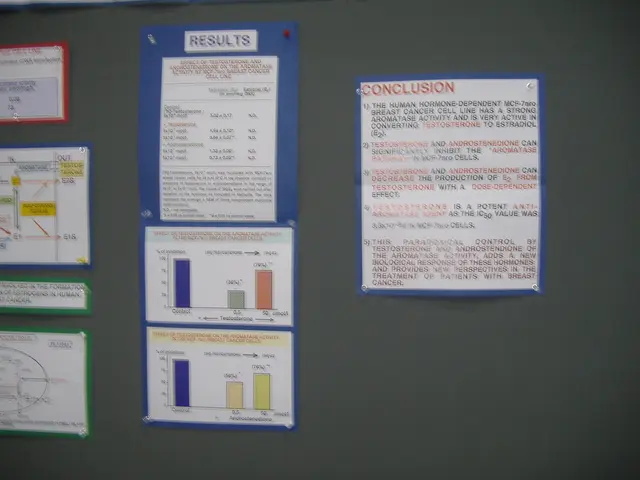Rapid Increase in Chikungunya Cases in China Stirs International Worry
In response to a large outbreak of the Chikungunya virus (CHIKV) in Guangdong province, China, authorities have implemented a multi-pronged approach to prevent the spread of the disease. This strategy includes aggressive mosquito control, case management, and environmental interventions [1][2][3].
Mosquito control efforts are intense, with the use of drone-based fogging to apply insecticides, household quarantines, and the installation of insecticide-treated window screens and bed nets in patient rooms [1][2]. Indoor areas are treated with residual insect repellents, and targeted adulticide spraying is carried out within a 100-meter radius of confirmed cases’ residences and workplaces. Mosquito breeding sites are systematically eliminated, and real-time vector surveillance is conducted using indices like the Breteau Index to monitor mosquito populations and optimize control efforts [2].
Healthcare facilities integrate routine nucleic acid testing and active case detection, combining differential diagnosis to distinguish chikungunya from similar diseases such as dengue [2]. Despite the lack of a chikungunya vaccine, these integrated vector management and public health strategies have been key in controlling transmission during this major outbreak [3]. Enforcement measures such as fines for non-compliance with mosquito control at the household level also play a role [1].
The unusual scale and speed of this local transmission suggest that climate change and urbanization may be contributing factors. Increased environmental suitability for Aedes mosquitoes (vectors of chikungunya) due to warming temperatures and urban expansion is implied by the outbreak [1]. Urban settings with high-density human populations provide breeding habitats and feeding opportunities for Aedes mosquitoes, while climate change extends their geographical range and lengthens transmission seasons, contributing to increased CHIKV risk [1].
Similar strategies are being employed in other affected regions, including mosquito control through larval source reduction, public education campaigns, surveillance systems, and adapting strategies to climate impacts [4].
The World Health Organization (WHO) and Chinese CDC attribute the outbreak to rising temperatures, urbanization, and increased mosquito density. The gravity of the China chikungunya outbreak has led to revisions in China's national disease surveillance system [5].
The WHO has raised regional alert levels for South and East Asia due to the China chikungunya outbreak, and average temperatures in Guangdong during June and July 2025 were 2.3 degrees Celsius above the decadal average [6]. International air travel could potentially become a transmission vector for the chikungunya virus, and urbanization without proper mosquito-safe drainage systems exacerbates the risk of outbreaks [7].
Experts fear that Chikungunya may become endemic to parts of East Asia if climate patterns continue to support mosquito survival across seasons. Many cases of Chikungunya may go undiagnosed due to symptom overlap with dengue and Zika or due to asymptomatic infections. Pharmaceutical researchers in Shanghai and Beijing have begun fast-tracked preclinical trials for a Chikungunya vaccine, based on mRNA platforms [8].
Calls for wider surveillance and improved data-sharing protocols have been made due to the challenge of undiagnosed or misdiagnosed cases. Poor vector surveillance in peri-urban slums and remote rural clusters has allowed the chikungunya disease to circulate unnoticed before hitting urban cores. Aedes albopictus, which thrives in temperate China, is also capable of transmitting the chikungunya virus, potentially allowing the outbreak to spread to northern provinces [9].
Emergency health units have been deployed in affected urban zones, and more than 25,000 medical staff have been deployed across southern provinces to conduct temperature checks and distribute basic treatment packs. Guangdong and Guangxi provinces have reported over 85% of the confirmed cases, with the China chikungunya outbreak seeing over 7,000 confirmed cases [2][10].
The WHO has reiterated the importance of global cooperation in tracking, responding to, and mitigating outbreaks like the China chikungunya outbreak, especially as the world prepares for an era of climate-driven health emergencies [11].
- Science has been crucial in understanding and addressing medical-conditions like the Chikungunya virus (CHIKV).
- The field of environmental-science is investigating the impact of climate-change on the spread of respiratory-conditions such as CHIKV.
- The manufacturing industry is developing solutions to combat digestive-health issues, including new medications and dietary supplements.
- Eye-health researchers are exploring the causes and treatments for common eye disorders, using advanced technology like artificial-intelligence.
- The hearing industry is working on innovative hearing aids and cochlear implants to improve hearing for those with impairments.
- Autoimmune-disorders are a complex issue in personal-health, requiring careful management and research.
- The energy sector is investing in renewable sources to combat climate-change and its impacts on environmental-science.
- Finance plays a role in the development of healthcare facilities and medical technology, supporting the screening and treatment of a variety of medical-conditions.
- Businesses are implementing wellness programs to promote cardiovascular-health among employees.
- The industry is using data-and-cloud-computing to improve the efficiency of neurological-disorders research and treatment.
- Skin-conditions are a common concern in the fashion-and-beauty industry, with many products aimed at addressing these issues.
- Space-and-astronomy researchers are studying the effects of space travel on the human body, including potential risks to cardiovascular-health.
- Retail establishments are implementing sustainable practices to reduce their carbon footprint and contribute to environmental-science.
- Transportation companies are testing autonomous vehicles to improve safety and reduce accidents, benefitting several areas of personal-health.
- Cybersecurity measures are essential in protecting personal-finance and banking-and-insurance data from theft.
- Lifestyle choices can have a significant impact on eye-health, with habits such as regular screen breaks and adequate hydration being important.
- Fashion-and-beauty trends are often influenced by Skin-conditions, with products being developed to address specific concerns.
- Food-and-drink companies are adapting to meet the demands of those with digestive-health issues, offering alternatives to common allergens.
- Investing in environmental-science is crucial for managing the risks posed by climate-change to various industries.
- Wealth-management strategies can help individuals protect their assets and plan for retirement, addressing personal-finance concerns.
- Home-and-garden retailers are offering eco-friendly products to support environmental-science and reduce environmental impact.
- The business world is closely watching trends in gadgets and technology, as these can impact various areas of personal-health.
- Data-and-cloud-computing is essential for the management of medical records and health information, promoting responsible-gambling and improving healthcare.
- Pets can have a positive impact on mental-health, providing companionship and reducing stress levels.
- Travel companies are promoting eco-friendly practices to reduce the environmental impact of tourism.
- The car industry is investing in electric and hybrid vehicles to reduce carbon emissions and combat climate-change.
- Bookstores are offering a wide variety of books on education-and-self-development, including topics like personal-growth and big-wins.
- Shopping malls are implementing sustainable practices to reduce their carbon footprint and promote environmental awareness.
- Social-media platforms are a valuable tool for staying informed about current events, including general-news, crime-and-justice, and politics.
- Movies-and-TV shows often explore themes related to relationships, presenting both positive and negative portrayals.
- Career-development resources are available for those seeking to advance in various industries, including casino-and-gambling, casino-games, and lotteries.




